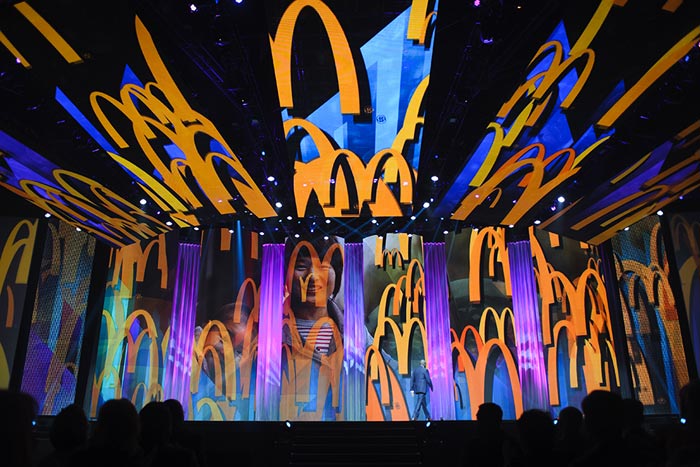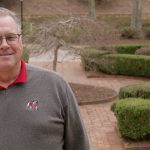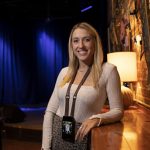Through reinvention, sustainability and social media prowess, three companies found the keys to power innovative conferences. It’s a convention strategy that sounds more like a magic trick, framed by a simple question: How do 16,000 people not leave a footprint?
For half a decade, McDonald’s built its Worldwide Convention around answering that riddle. And while the restaurant chain learned it’s not easy leaving no trace, its inventive sustainability program has allowed the company to leave behind less and less.
“We’ve been focusing on sustainability as a specific discipline for our shows since about 2008, and we’ve been lucky to have partners—from our general service contractors to the destinations—really help us further our efforts,” says Julie Larson, meetings and events project manager for McDonald’s. “I’m proud of the success we’ve had in trying things that have never been done before.”
As companies ramp up for annual meetings, finding innovative ways to engage attendees while bolstering brand recognition is a necessity. Three companies in particular—McDonald’s, Sage North America and Cisco—developed fresh goals for their respective 2014 conventions based on feedback gauging successes and failures from previous conferences. For McDonald’s, which holds its Worldwide Convention every two years in Orlando, sustainability, education and entertainment are the staples. At Sage, suiting a conference to attendees’ wants and needs spurs a high level of reinvention; while Cisco turns its technical experience and social media prowess into a powerful combination as it celebrates 25 years of Cisco Live.
“I think events in the last few years have really started to change—and not just for us,” says Gabie Boko, executive vice president of marketing at Sage. “The whole point of innovation is not to innovate because you are required to, but to be provocative as to your own strategy and plan. That’s what we try to do.”
Leave No Cup Behind
A global company such as McDonald’s thinks on a massive scale, so a conference isn’t only a conference, it’s a chance to educate its workforce beyond the realm of its restaurants. For Larson’s team, this means sternly pushing a green message to attendees before, during and after the conference while constantly evaluating to see where its environmental footprint stands. It means being proactive in the Orlando community with sweat equity projects, donations and giveaways. And it means everyone gets involved.
“There’s a saying out there—I don’t really know if it’s true—that the convention industry is one of the largest waste producers, and we’re really trying to be mindful of that,” says Larson.
During the 2012 Worldwide Convention, attendees (who include McDonald’s franchisees and suppliers from all over the globe) generated more than 1 million pounds of solid waste, but 66 percent of that was diverted from the landfill through recycling (513,000 pounds), composting (84,000 pounds) and donations (67,000 pounds). Larson wants to increase that percentage at this year’s convention, the 26th since McDonald’s started a company-wide conference in 1965 (back then, it was called the Owner Operator Convention).
“We put a stake in the ground to try and reduce the trash coming out of the building by 10 percent in 2014,” says Larson. “We’re telling everyone to be mindful of the resources and the substrates they’re using as they build their booths, pick their menus and decide how they’re getting to Orlando.”
They encourage exhibitors to use environmentally friendly materials or showcase more energy efficient products (fryers that use less oil, for example). McDonald’s works with hotels hosting attendees to ensure in-room items such as unused soaps or body wash are donated to the community.
Once attendees arrive in Orlando, there’s more in store than being mindful of plastic cups and unwanted waste. The social media team, led by Lisa Fingerhut, engagement product manager, has added two Internet wrinkles to set McDonald’s apart. The first comes from open collaboration. McDonald’s partnered with social engagement platform Mass Relevance to “implement a social media mosaic that will aggregate content from Facebook, Instagram, Twitter and Vine into one platform,” which will be displayed live on the exhibit floor, Larson says. The other is based on internal discussion, where a closed social network is available to attendees through the mobile app “because of the sensitivity and proprietary nature of a lot of what we will be talking about at the convention.”
And then there’s singing. Voice of McDonald’s, a biennial competition among employees that started in 2006 with 2,500 submissions from 41 countries and
has grown to 58,000 submissions from 63 countries, culminates at Worldwide when the 16 semifinalists perform in an arena concert in front of thousands of McDonald’s employees. This year’s winner will take home $25,000, and past winners have performed with Kelly Clarkson and Keith Urban while recording songs for major motion pictures.
“It was an idea that came out of senior management,” says Larson. “They wanted to create a singing contest for our restaurant employees that would shine a spotlight on their musical skills for the international language of music. It’s really been an incredible tool to help us inspire the system, build the brand and really energize our crew and managers to achieve dreams beyond McDonald’s that they may have never thought possible.”
Now For Something Completely Different…
There was a chance that not so long ago, the topic of innovative meetings wouldn’t have applied to Sage. It wasn’t because Sage, a leader in business software for small to mid-size “engines of the economy,” as Boko says, didn’t understand the pulse of its audience. In fact, a three-year study showed Sage may have known its audience too well, and the consensus was meetings, such as its annual Sage Summit, weren’t telling attendees what they wanted to know for the money they were investing.
“Attendees were telling Sage, ‘I’m looking for help, but I can’t find it from you,’” says Boko. “We took a look at all of that, and we thought, clearly, we need to be listening much more effectively.”
Sage determined an annual meeting was critical to its strategy, but after 15 years under different guises, it had to change its philosophy. Sage discovered through surveys that its attendees,who include annual customers and development partners, looked to them for thought leadership. But attendees said the summit was too expensive for the value they received. So for this year’s July summit in Las Vegas, Sage slashed the cost of early bird customer tickets to $99 and knocked down partner passes to $399. Registration began in early April, and Boko expects the number of attendees for the summit to almost double to 6,000, with another 2,000 to 3,000 people participating online.
The company unveiled a series of webcasts for three of its products, entering each webcast attendee into the Sage “Be the Driver” event sweepstakes. Prizes include round-trip airfare to Las Vegas, hotel stays and a chance to partake in the World Class Driving Exotic Car Experience during the summit. The webcasts point to another of Sage’s changes: communicating information usually reserved for the annual summit as part of a year-round conversation.
“We thought, why are we only communicating this stuff once a year if we really want this event to be a culmination of thought leadership?” Boko says. But it’s at the summit where the real change takes place, as TED-style talks, comfy couches and digital boards will abound; support centers will match Sage product experts with customers; and workshops will feature leading minds from all types of businesses—not only from people at Sage. All of it will be pushed by social media that has been shared by attendees virtually and in person, and instead of designating an area for social media, the entire floor space is social media central.
“We’ve clearly been playing with this, and now we have a strategy that says ‘This is what we want it to be.’ We’ve heard, we’ve listened, we’ve trialed this for the future, so we consider this, honestly, the first year we’ve ever done it like this,” Boko says.
This unified space, based this year at Mandalay Bay, will be like a large living room. It will have booths that merge with open space, allowing up to 20 people to hold a Google Hangout to answer questions posed on a nearby digital board. Boko says there are still some people who want the typical meeting room setting where the thousands of tips and tricks are shared, but Sage is going ahead with its new platform regardless.
“This makes us the host of conversations, not necessarily the driver, and that is a big change for us,” Boko says. “It’s content that isn’t about our product anymore. Now it’s about inviting people to come and have a conversation with like-minded people. We’re not driving it about Sage—we’re driving it about the topic.”
Bringing In the Tech Guys
Cisco, a multinational corporation that designs, manufactures and sells networking equipment, had a question to address before its annual Cisco Live event: How do you extend your content and your audience beyond the four walls of the convention center?
For Cisco global marketing strategy manager Staci Clark, the answer is through constant, yearlong engagement via social media and using that campaign during the annual event to create a fun, connected atmosphere reacting to every tweet and post. Employing a team to monitor what’s posted in the digital world (i.e., “Hey, there’s a bird trapped in ballroom five”) results in a maintenance man five minutes later to help free the bird (yes, this actually happened).
“They understand that you’re listening,” Clark says, “and you get a lot of, ‘What’s the big unveil this afternoon?’ or ‘How do I get backstage tickets to the concert?’” (The latter question was a popular one this year, as Lenny Kravitz and Imagine Dragons headlined a customer appreciation event at AT&T Ballpark.)
This caused a conversation with the digital audience, spurred by a huge space at Cisco Live where attendees’ tweets and retweets are posted on large screens, attracting a steady audience. The strategy proved so successful during the 2013 convention that Cisco was a trending topic on Twitter twice, second only to the Supreme Court’s ruling on the marriage act, which happened on the same day.
“Obviously big news was happening, and we trended twice,” Clark says. “We had 46,000 mentions at Cisco Live that week. Our attendees really do expect social media to be part of their experience.”
Cisco found a way to make its hardware a desired attraction as well for the IT professionals and telecommunications and service providers who attend the conference. Instead of relying on others, Cisco uses its expertise as an equipment manufacturer to create a campus-grade network that is built and torn down in a matter of days.
It’s a big hit with the “tech guys,” Clark says, because the attendees see how “a pretty huge, heavy-duty network” that supports 20,000 users and more than 40,000 unique devices with 500 access points works in a real-life situation.
“It’s always the latest, greatest, cutting-edge gear, so it’s become not only the support system for the conference but a showpiece for attendees,” Clark says. “If you’re a tech engineer looking at this ubernetwork and the people who built it and are working it and managing it, you can go in and talk to them, and you can tour it. It’s become a pretty interesting way to showcase the technology and support the conference.”
The tech and social media push has done wonders for Cisco’s attendance, as the number of attendees rose from 10,000 in 2009 to 20,000 in 2013, with more than 20,000 expected for this year’s conference. The move to live broadcasting a few years back (all 600 sessions, free to watch) was met with skepticism, as some wondered if Cisco wasn’t cannibalizing itself. But it proved a powerful tool, turning online watchers into attendees, making Cisco Live a must-see in the tech world.
“What we found is that the online experience absolutely drives demand for the in-person experience,” Clark says. “It’s two different experiences, and you choose which one you are able to do. We’ve never had a situation where people were saying, ‘I’d rather just stay home and watch it.’
“The way I think about it, if you had a ticket to the Super Bowl, you would absolutely go,” Clark adds. “You would never say to yourself, ‘Gosh, if I could watch it on TV, why would I go?’”




